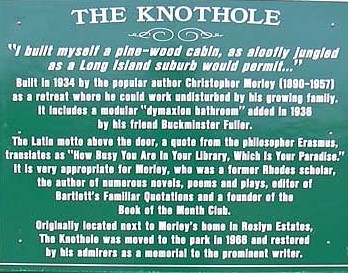Failing to find the bathroom in the park
While anyone may build a shed of sorts in which to escape the hubbub at home, they are not likely to have it equipped with a Dymaxion bathroom. But as Morley was a close friend of the man who dreamt up the design, he got on for his Knothole. Curiosity about that drove me to visit the park to see this marvel of easy-cleaning engineering that dates back to 1936. Alas, you cannot see anything inside the Knothole, which is kept closed and is falling into a sad state of disrepair.
What it should have looked like is this:
source https://slideplayer.com/slide/4283236/
The bathroom would have been made out of metal in a very compact and efficient design that was meant to be very easy to clean. Fuller did plan to one day render it in plastic for greater comfort, but the ones he did get made were metal. The bathroom was supposed to be just one component of the highly efficient Dymaxion house that he was hoping would take off but never did.
Even Morley's Knothole follows very traditional-looking architecture with nothing that would make you expect it houses a revolutionary design. In contrast, the full Dymaxion home was meant to be modern all around, and I do mean round. See the vintage video that showcases it here:
Reading Fuller
With my curiosity piqued, I checked out several Bucky Fuller biographies from my library last year. But despite being a pretty fast and determined reader, I couldn't make it through them. But in August, my library got in a new bio, and this one I was able to read within the allotted two weeks for new books. It's Inventor of the Future: The Visionary Life of Buckminster Fuller.
If I were to give it a star rating, I'd probably give it 4/5. It's highly readable despite the geometric details entailed in describing Fuller's concepts and their applications that endure beyond his own lifetime (like the carbon formation that resembles a soccer ball that was named Buckminsterfullerene AKA Buckyballs in his honor).
However, I don't fully buy into the parallels that Nevala-Lee attempts to draw with modern day influential figures and Fuller. Not all people who may be described as visionary or innovative operate in the same way. Certainly, Fuller was never was a major commercial success and really did not have good business sense at all.
This account of Fuller may upset some people. Other descriptions of him focused on his creativity and presented him as a kind of magnanimous leader. But the take on his personality here is much darker. There are several account of fallouts with people who felt they were shortchanged on credit for concepts or who were cut out of Fuller's organization because he refused to cede control.
Worse than that are the glimpses into his more private life that shatter the romantic story of his marriage. He remained married for over 60 years and was not even parted from his wife in death.They shared a funeral and a grave. Yet he cheated on her repeatedly -- sometimes with women young enough to be his daughter or just barely of legal age. It seems he bought into a kind of myth he created of himself and associated these women with muse-like figures, linking them to particular discoveries, as he wrote in a certain account himself. But the marriage itself reflects some of the Long Island connections that the book brought to light.
Fuller and Long Island History
What struck me in particular is that Fuller was married at Rock Hall, a colonial house that has been a museum since the middle of the 20th century. But in the early part of that century, it was still being
used as a home by the Hewlett family. Fuller's wife, Anne, was a Hewlett, and her wedding took place in that house. The Fullers even lived in Lawrence for some time and attended a church in Far Rockaway.* As someone who grew up in that area and who has visited Rock Hall a few times, I found it striking that such a famous person had such a strong connection to the place is not featured at the museum at all.
used as a home by the Hewlett family. Fuller's wife, Anne, was a Hewlett, and her wedding took place in that house. The Fullers even lived in Lawrence for some time and attended a church in Far Rockaway.* As someone who grew up in that area and who has visited Rock Hall a few times, I found it striking that such a famous person had such a strong connection to the place is not featured at the museum at all.
But there is yet another location on Long Island that is connected to the Fuller name. That is his great-aunt, Margaret Fuller. If you visit the Fire Island Lighthouse -- or its site -- you can find an account of the shipwreck that proved fatal to her and her young son when she was returning to the United States from abroad
Nevala-Lee does make much of the Margaret-Bucky connection, as they both had a strong sense of purpose and conviction that they were particularly endowed with abilities to use to guide the world. Bucky even took a nautical image to express that -- not of a lighthouse but of the small end on a ship's rudder that can determine its direction -- the trim tab. In fact that is what he had inscribed on his gravestone pictured below:
https://commons.wikimedia.org/wiki/File:Bucky_TRIMTAB.jpg
*One thing the author does get wrong is the name of the hospital in Far Rockaway. He mentions that Anne went to St. Joseph's in Far Rockaway, but the name of the hospital is St. John's. It's still there.
Related:
How many times did Edison fail in attempting to invent the light bulb?





No comments:
Post a Comment